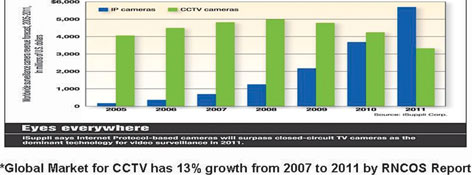

Local distributor Miro examines the future of IP surveillance based on an iSuppli report released recently.
The IP surveillance industry has been on a steady growth incline for the past few years and is still accelerating. Market intelligence company, iSuppli Corporation released its views on the CCTV industry compared with IP surveillance and has determined that IP surveillance sales figures will overtake that of CCTV by the year 2011. This is largely due to the advanced functionality and easy integration of IP surveillance.
Although IP surveillance has opened the doors for many different types of functionality, there are 10 main reasons why IP surveillance is quickly taking over the CCTV market.
1. Power over Ethernet
One of the first advantages of IP surveillance over that of CCTV is Power over Ethernet or PoE for short. PoE allows for transfer of power and data to an IP camera or surveillance device, over a single piece of cable. So you are no longer required to power your security devices by separate power outlets, but rather all from one location.
2. Megapixel resolution
Megapixel image resolution surveillance systems currently offer up to 20x the resolution of traditional cameras, allowing for greater detail and easier identification when you need it. Although much higher quality recordings are available with megapixel resolution, the storage requirement is much smaller than you may imagine, due to compression techniques that have been developed and tested for the IP surveillance industry.

3. Camera level intelligence
Intelligence at camera level enables features such as alarm management, image enhancement, number plate recognition and people counting which means a more productive and effective means of surveillance. Many cameras today even have built-in electrical switching mechanisms, allowing you to wire your IP camera into an electrical circuit such as an alarm system or even an electric gate motor, and activate the electrical circuit remotely.
4. Pan, tilt and zoom control
Integrated pan, tilt and zoom (PTZ) control over the same network cable. Traditional surveillance cameras require separate cabling from that of the video signal which is both costly and cumbersome. This allows for greater cost savings and shorter installation times.
5. Integrated audio
Again in the CCTV world, traditionally only available with separate cabling to a digital video recorder. With a networked IP surveillance infrastructure, audio can be captured by the camera itself, synchronised with the video and integrated into the same video stream. Two way audio is also possible if required which allows the user at the control room to talk back to the camera viewing site via a microphone.
6. Secure communication
Standard surveillance cameras have no encryption or authentication methods to secure the video signals, meaning that anyone can tap in or replace the signal from a camera with another camera signal. Networked surveillance addresses all of these issues offering methods of secure image capturing and transmission.

7. Image quality
Vastly superior image quality to that of standard cameras, offering full image details with precise, accurate information using progressive scan.
8. Utilisation of existing infrastructure
Analogue cameras require expensive coax or fibre. Distances with coax will affect image quality and when requiring power, inputs/outputs and audio, the situation is complicated even further. Internet Protocol (IP) cameras run on an established, standardised and inter- operable network infrastructure. With digital images there is none of the reduction in image quality that is typically associated with analogue. This also allows for the use of Wi-Fi networking to be used for long distance camera sites. No longer are there any major limitations as far a distance is concerned due to the multitude of advancements concerning Wi-Fi networking and its distance increases over the past few years.
9. True digital
Networked surveillance offers a true digital solution. Traditional cameras work by digitising an analogue signal in the cameras digital signal processor (DSP). This signal is then converted back to analogue for transport over the coax cable. Finally, the signal is digitised at the digital video recorder (DVR) for recording. With a networked surveillance system, signals are digitised only once, meaning no unnecessary conversions and no image degradation. This also allows for multiple technologies to inter-operate in a standardised way. Because everything is digital and remains digital, you can now view you cameras over the Internet, or directly on your cellphone.
10. Lower total cost of ownership (TCO)
Lower total cost of ownership is easily achieved when comparing the cost per channel, flexibility and performance.
There are many more reasons why IP surveillance is doing as well as it is in these current times, but the really exciting thing about IP surveillance is that the list of possibilities and functions will continue to grow and evolve throughout the coming years due to inter-operability and pure imagination. People have always had amazing ideas relating to the security industry, but now they have a way to implement them!
| Tel: | +27 12 657 0960 |
| Email: | [email protected] |
| www: | www.miro.co.za |
| Articles: | More information and articles about MiRO |

© Technews Publishing (Pty) Ltd. | All Rights Reserved.